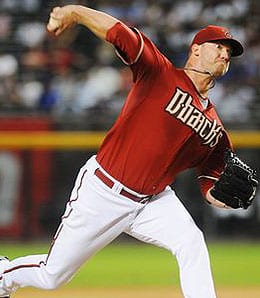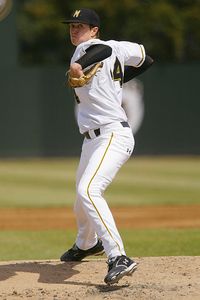In the Los Angeles Angels' farewell tour of the Metrodome, the Twins were outscored 35-15. LA Times beat writer,
Mike DiGiovanna, provides some of his more memorable moments while covering the Halos in the Dome. Writes DiGiovanna of the facility: "
It just has no charm. The grass is plastic, the roof is sometimes impossible to find fly balls in, and the building has no real distinguishing characteristics. It's basically a football stadium the Twins happen to play baseball in. There is nothing aesthetically pleasing about it. About the only thing good you can say about the place is that it's not quite as depressing as the old Kingdome in Seattle."
Following the dismantling of the pitching staff,
Joe Christensen suggested a few arms that maybe available in the weeks leading up to the waiver deadline of August 31st. On the list are Arizona's Jon Garland and Doug Davis, San Deigo's Kevin Correia and Seattle's Miguel Batista. Batista has little control (5.15 BB/9), Correia has been better with the addition of a slider and, judging by the Cla Meredith trade, the Padres have not figured out what market-value means and Garland has been in steady decline. Davis is the only one among the group that appears to be the most intriguing.
Speaking of Meredith, since the Orioles acquired him, he has thrown 5.2 innings, struckout five and walk none while giving up just one earned run during Boston's 18-10 assult on Baltimore. Are you telling me we did not have a spare utility player lying around?
Sometimes an All Star break can be too relaxing. Since returning from the hiatus, Bobby Keppel has pitched 10 innings and allowed 11 earned runs (9.90 ERA) on three home runs and an opponant slugging percentage of .619.
Sid Hartman says that former Twins pitcher and radio broadcaster
Jack Morris believes this Twins pitching staff (27.6 avg years old -3rd in AL) needs an infusion of veteran talent if it plans on reaching the next level. The Twins attempted to bring in Jarrod Washburn at the trade deadline before Detroit acquired him from Seattle but, by Hartman's account, the Mariners requested
Glen Perkins in exchange for Washburn and the Twins flat-out refused. Take that with a grain of salt because, as
John Bonnes noted, Hartman essentially fabricated the entire Sanchez-for-Liriano trade rumor a few weeks ago.
Here's an example of the recent acquired
Orlando Cabrera providing one of those veteran "intangibles". During his pregame, welcome-to-the-team interview Cabrera proceeded to answer the first question in his native tongue -- probably to the dismay of the mostly Midwestern born-raised Twins beat writers. The shortstop smiled and
quipped, "They told me you guys speak Spanish."
Even though Cabrera might not be the long-term answer for short,
Tyler Ladendorf represents a prospect that has the raw tools but has yet to demonstrate that he is capable of moving up the organization's ladder at a rapid pace, and in that context, he's not such a hefty ransom. At 21 years old and still unable to figure out low-A pitching in the Midwest League, shortstop Ladendorf was far from the high caliber prospect the Twins thought they had when they drafted him in the second round in 2008 and signed him to a nearly $700K bonus. As
Baseball America notes "The toolsy Ladendorf, 21, has been a disappointment thus far in his pro career. The righthanded batter was hitting 233/.292/.267 in his first 60 at-bats for low Class A Beloit, having spent most of the season in extended spring training and then tearing up the Appalachian League for 15 games."
In order to clear room for Cabrera, the Twins sent
Brian Buscher to AAA Rochester. Buscher's role as a left-handed pinch hitter never fully materialized, but the 28-year-old did go 3-for-13 (.231) while drawing walks in 6 of 20 pinch hitting plate appearances leading to a .500 on-base percentage. Despite having his best month of the entire year (9-for-28, .321 BA, .406 OBP), Buscher had options remaining and providing the least flexibility among role player so it seemed obvious that he would be the one demoted. Rochester still has to
make a roster move to make room for the incoming third baseman.
Kelsie Smith notes that the loud noise
Justin Morneau made urging the Twins to add an impact player at the trade deadline came at the expense of having Buscher, a close friend of Morneau's, sent to Rochester. Subtle jab back at the clubhouse from the front office? According to Smith,
Ron Gardenhire said prior to the decision to move Buscher, "Sometimes it's be careful what you ask for with players, though, too, huh? We'll see. We'll see how it all works out."
La Velle E Neal reports that
Francisco Liriano threw in a bullpen session on Sunday. Feeling fine, Liriano plans to start on Wednesday against the Cleveland Indians. By the way, Liriano leads the MLB with 16 four-pitch walks.
Bill Smith has seemingly distanced himself from the actual decision-making responsibilities.
Patrick Reusse provides details of Smith's post-trade press conference in which the Twins GM noted the difference between the way he operates and how the former regime did. "I'm an administrator; Terry's an evaluator," Smith
said. "When it was time to make a decision, Terry listened to his assistants but relied on his evaluation. Those decisions are now reached more by consensus." So, whereas Ryan would accept accountability, Smith is suggesting that the buck stops there, that guy over there and three office door's down the hall as well.
The 16-year-old German prospect
Max Kepler-Rozycki, whom the Twins signed for $800K, suffered a foot injury in the Bavarian championship a few weeks ago and
has been on crutches and will not play in the European Championships this month.
Interesting piece in the Wall Street Journal on
Dan Okrent who pioneered a new stat in 1979 called IPRAT or "Innings Pitched Ratio". This would later be known as WHIP, as it is the measurement for walks plus hits divided by the amount of innings pitched. Okrent, who authored one of the better baseball books on my bookshelf called "
9 Innings", came up with this statistic to add to his new creation, 'Rotisserie' baseball, which was a precursor for the millions of fantasy baseball leagues. Since the proliferation of the WHIP statistic, researchers found a strong correlation to it and future performance of a pitcher. Despite the predictable parallels, teams, such as the Tampa Bay Rays, shy away from using it as a evaluator.
Says Dan Feinstein, director of baseball operations for the Rays “Once a ball is hit, the pitcher has no control over the outcome of the play, with the exception of the home run. There are too many factors that determine whether or not that ball will be a hit, including ballpark size and dimension, positioning of the defense and ability of his defenders.”
Which is why some put emphasis on another metric: expected FIP or xFIP. The Royals' statistical minded starting pitcher Brian Bannister tells
Bob Dutton that “I think the ultimate stat for a pitcher is
xFIP,” Bannister
said before pausing and offering a wry grin. “I know that’s getting really technical. It’s fielder independent pitching adjusted for your home-run rate back to the league average. That shows a pitcher’s true level of talent. Baseball doesn’t have a strength-of-schedule element like college football does.” Using the xFIP metric, the top Twins starters are:
|
Pitcher |
xFIP |
|
S. Baker |
4.10 |
|
K. Slowey |
4.39 |
|
F. Liriano |
4.57 |
|
G. Perkins |
4.94 |
|
N. Blackburn |
4.96 |
|
A. Swarzak |
5.30 |
Josh Johnson has a July review of the organization's minor league system.
What was
Ron Gardenhire like back in Okmulgee High School in Oklahoma?
Mike Baldwin says pretty "low key".
 A former closer while with the Washington Nationals, Rauch’s season opened to some powerfully unsexy numbers. In 18.2 innings over 22 appearances, opponents slugged .530 off of him including three of his five home runs allowed. It was this first-half performance that incited us to write Rauch off as “not a guy you would want in a Twins uniform late in a ballgame” for the TwinsCentric Trade Deadline Primer. How were we supposed to know that Rauch would turn things around? Post-May 25th, Rauch improved his location by dropping it down in the zone (51.4 percent post-May, 44 percent April-May). Since then hitters have been unable to make as solid of contact, slugging just .364 off of him and he has procured a 2.84 ERA in 31.2 innings in 33 games.
A former closer while with the Washington Nationals, Rauch’s season opened to some powerfully unsexy numbers. In 18.2 innings over 22 appearances, opponents slugged .530 off of him including three of his five home runs allowed. It was this first-half performance that incited us to write Rauch off as “not a guy you would want in a Twins uniform late in a ballgame” for the TwinsCentric Trade Deadline Primer. How were we supposed to know that Rauch would turn things around? Post-May 25th, Rauch improved his location by dropping it down in the zone (51.4 percent post-May, 44 percent April-May). Since then hitters have been unable to make as solid of contact, slugging just .364 off of him and he has procured a 2.84 ERA in 31.2 innings in 33 games.  Ron Mahay, on the other hand, is flotsam that has fallen from the Royals organization. Kansas City inked Mahay to a two-year, $8 million deal that was fueled by good intentions and in effort to capitalize on his successful 2007 season but the results were terrible when put into practice. Following his season split with Texas and Atlanta in a year when he limited left-handed batters to a .189 batting average (.542 OPS), Mahay became a valued commodity for teams looking for bullpen help. For whatever reason, the Royals opened their pocketbooks to a 36-year-old reliever coming of an artificially created career year and wound up with an expensive mess. Mahay followed up the 2007 season by getting shelled by opponents for two straight years – even against same-sided batters who hit .269/.321/.429 off of him in that duration.
Ron Mahay, on the other hand, is flotsam that has fallen from the Royals organization. Kansas City inked Mahay to a two-year, $8 million deal that was fueled by good intentions and in effort to capitalize on his successful 2007 season but the results were terrible when put into practice. Following his season split with Texas and Atlanta in a year when he limited left-handed batters to a .189 batting average (.542 OPS), Mahay became a valued commodity for teams looking for bullpen help. For whatever reason, the Royals opened their pocketbooks to a 36-year-old reliever coming of an artificially created career year and wound up with an expensive mess. Mahay followed up the 2007 season by getting shelled by opponents for two straight years – even against same-sided batters who hit .269/.321/.429 off of him in that duration. 
 Rest of the season he has good luck? It is a sobering thought to realize that a pitcher who is 7-8 with a 5.61 ERA is a sound addition to your rotation, but that is what
Rest of the season he has good luck? It is a sobering thought to realize that a pitcher who is 7-8 with a 5.61 ERA is a sound addition to your rotation, but that is what 
